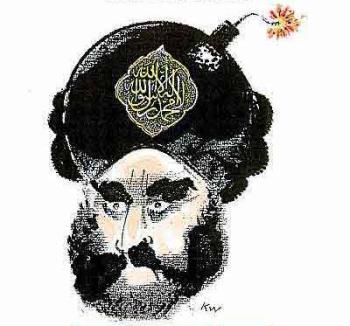King Pearhead
 La Caricature was a satirical journal in nineteenth-century France. Set up by the artist Charles Philipon, it provided biting comments on the worlds of arts and politics. First and foremost among its victims was King Louis Philippe, invariably portrayed with a ludicrous pear-shaped head. In fact, attacks on the monarch became so vicious that Philipon was jailed and his journal forced to cease publication after just five years, although it would later rise from the ashes. When it came to fighting for the “right to insult”, La Caricature was at the forefront.
La Caricature was a satirical journal in nineteenth-century France. Set up by the artist Charles Philipon, it provided biting comments on the worlds of arts and politics. First and foremost among its victims was King Louis Philippe, invariably portrayed with a ludicrous pear-shaped head. In fact, attacks on the monarch became so vicious that Philipon was jailed and his journal forced to cease publication after just five years, although it would later rise from the ashes. When it came to fighting for the “right to insult”, La Caricature was at the forefront.
Literature
• James Cuno, Charles Philipon and La Maison Aubert: The Business, Politics and Public of Caricature, 1820-40(Dissertation; Harvard University 1985)
• Robert Justin Goldstein, Censorship of Political Caricature in Nineteenth-Century France (Kent, OH 1989)
• David Kerr, Caricature and French Political Culture 1830-1848: Charles Philipon and the Illustrated Press(Oxford 2000)




 In many countries, the stereotype of Germans as Nazis has never vanished completely. The current eurozone crisis has sparked new life into this image, especially in financially troubled countries like Greece and Italy. Many people resent Germany’s insistence on severe reforms in their countries, seeing it as an unwarranted intrusion on their national sovereignty. Some even perceive the European Union as the “Fourth Reich”, insisting that the Germans have finally achieved their old Nazi dream of continental domination. On this poster, the Italian Partito Comunista exploits these sentiments by portraying German Chancellor Angela Merkel in military uniform, wearing a euro sign instead of a swastika on her arm.
In many countries, the stereotype of Germans as Nazis has never vanished completely. The current eurozone crisis has sparked new life into this image, especially in financially troubled countries like Greece and Italy. Many people resent Germany’s insistence on severe reforms in their countries, seeing it as an unwarranted intrusion on their national sovereignty. Some even perceive the European Union as the “Fourth Reich”, insisting that the Germans have finally achieved their old Nazi dream of continental domination. On this poster, the Italian Partito Comunista exploits these sentiments by portraying German Chancellor Angela Merkel in military uniform, wearing a euro sign instead of a swastika on her arm.